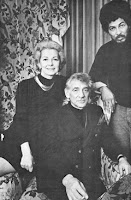That Party at Lenny’s
by D. Kern Holoman
 The term “radical chic” was invented to describe Leonard Bernstein. Tom Wolfe’s “That Party at Lenny’s” was an irreverent look for New York magazine at a 1970 fund-raiser held in the Bernsteins’ Park Avenue penthouse for the Black Panther Party. Few figures in orchestral history can have anguished so much as Bernstein did over personal identity and the place of one’s music in the world at large. Raised in the heady liberalism of Harvard and Franklin Roosevelt, mentored by Copland and his progressive political and social views, he could not resist the notion of podium as pulpit. The Palestine Philharmonic had begged him to stay, in 1946, since he spoke Hebrew and was a Zionist at heart; in 1948 he led them for two months, thirty-five concerts, during the War of Independence. Later, in New York, he was devastated by the assassinations of the 1960s, and bitterly and sometimes incoherently opposed everything about the Ronald Reagan administration. He features in the Watergate tapes of September 1971, on the occasion of the Mass he had composed to a commission from Jacqueline Kennedy to inaugurate the Kennedy Center. President Nixon, tipped by his security apparatus as to the work’s pacifist theme, skipped the premiere and in a follow-up discussion was told of Bernstein’s weeping onstage after the performance and kissing everybody in sight, “including the big black guy” (Alvin Ailey, the choreographer). Nixon responded, “absolutely sickening.”
The term “radical chic” was invented to describe Leonard Bernstein. Tom Wolfe’s “That Party at Lenny’s” was an irreverent look for New York magazine at a 1970 fund-raiser held in the Bernsteins’ Park Avenue penthouse for the Black Panther Party. Few figures in orchestral history can have anguished so much as Bernstein did over personal identity and the place of one’s music in the world at large. Raised in the heady liberalism of Harvard and Franklin Roosevelt, mentored by Copland and his progressive political and social views, he could not resist the notion of podium as pulpit. The Palestine Philharmonic had begged him to stay, in 1946, since he spoke Hebrew and was a Zionist at heart; in 1948 he led them for two months, thirty-five concerts, during the War of Independence. Later, in New York, he was devastated by the assassinations of the 1960s, and bitterly and sometimes incoherently opposed everything about the Ronald Reagan administration. He features in the Watergate tapes of September 1971, on the occasion of the Mass he had composed to a commission from Jacqueline Kennedy to inaugurate the Kennedy Center. President Nixon, tipped by his security apparatus as to the work’s pacifist theme, skipped the premiere and in a follow-up discussion was told of Bernstein’s weeping onstage after the performance and kissing everybody in sight, “including the big black guy” (Alvin Ailey, the choreographer). Nixon responded, “absolutely sickening.”
From The Orchestra: A Very Short Introduction (Oxford University Press, 2012), p. 125.

